|
- Catalog (in stock)
- Back-Catalog
- Mail Order
- Online Order
- Sounds
- Instruments
- Projects
- History Face
- ten years 87-97
- Review Face
- our friends
- Albis Face
- Albis - Photos
- Albis Work
- Links
- Home
- Contact
- Profil YouTube
- Overton Network
P & C December 1998
- Face Music / Albi
- last update 03-2016
|
1. Kusi Ku Nalongo Kusi Ku Salongo - Buganda region - 15:13
2. Muziguri Zitahe - Ankole region - 10:02
3. Omukago - Bunyoro region - 11:34
4. Lubaale wa Baana - Buganda region - 11:59
5. Nabirye Yazaala - Eastern region - 9:36
6. Abalongo Twabazala Babiri ne Nalongo - Buganda region - 10:39
- With members from the Naggalabi Indigenous Theatre (NIT), a community of artists with a centre in Naggalabi for local, traditional and contemporary arts and crafts. The institution was founded by Sylvia Namulema Kigula and Eric Jjemba Lutaaya and is located in Nsangi su county Wakiso district, Uganda.
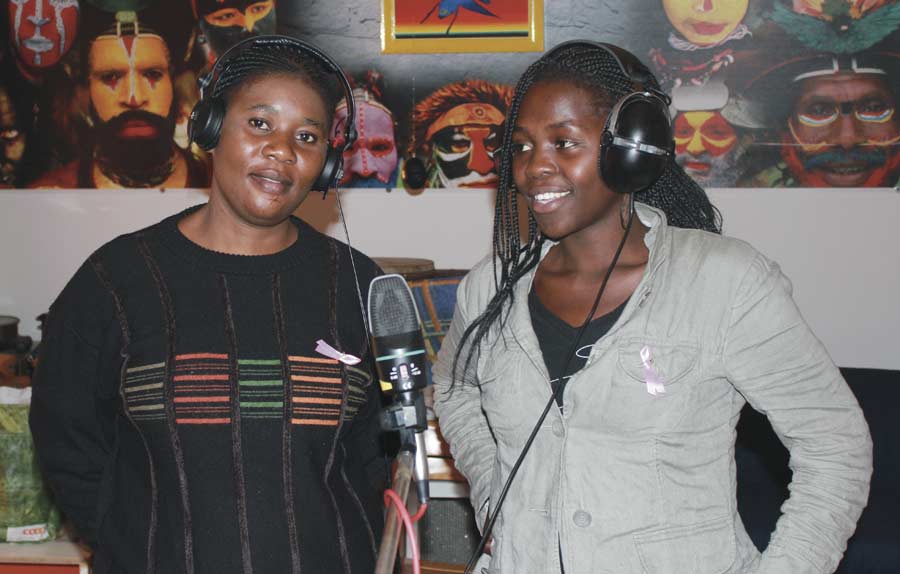 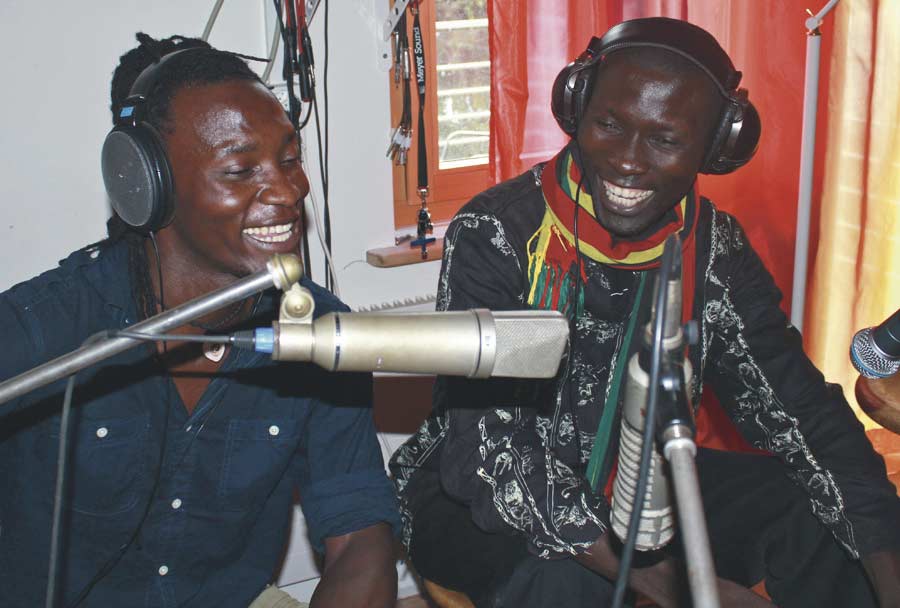
Syliva, Ritah - Israel, Eric
Africa is inhabited by different ethnic groups, each with a musical tradition of its own. This is a rich traditional music heritage that has been orally transmitted from generation to generation for centuries. Despite external influences, the majority of these ethnic groups continue to value and practice their respective traditional musical styles, which in turn have to establish strong musical and cultural identities and continue to do so.
Ugandan music is generally rhythmic and the complexity of these rhythms varies due to the difference between the ethnic groups. These differences are also reflected in the varied instrumentation. Some musical genres are played on simple instruments, while others, especially the dance music, are played in ensembles of complex instrumental formation. African music is usually pentatonic, but a few tribes also use a hexatonic scale. Most of the Ugandan vocal music is accompanied by traditional instruments. The literature embedded in vocal music is purposely meant to transform the social communities, i.e. in their structural adjustment.
Although Uganda is inhabited by a large variety of ethnic groups, a broad linguistic division is usually made between the Bantu-speaking majority, who lives in the central, southern and western parts of the country, and the non-Bantu speakers, who occupy the eastern, northern and north-western part of the country (these may be sub-divided into Nilotic and Central Sudanic peoples).
The Bantu people
The word Bantu itself, incidentally, simply means "human beings". These tribes all have Bantu as a core language in common, while their own languages usually comprise many dialects and variations. The ethno-linguistic Bantu group is most commonly said to have its origins in Western Africa (Cameroon). They are part of the Niger-Congo language family and have strong ancestral affinities with a group of languages being spoken today in southeastern Nigeria. The Bantu came from Central Africa, from where they began to expand to other parts around 2000 BC. These migrations are believed to have been the result of an increasingly settled agricultural lifestyle: although needing little land (far less than herding cattle use), land had to be fertile and well watered for cultivation to be a viable alternative. Population pressure in Central Africa may therefore have prompted the first Bantu migrations.
Bantu-speakers had entered southern Uganda probably by the end of the first millennium A.D. and they had developed centralized kingdoms by the fifteenth or the sixteenth century. Their languages are classified as Eastern and Western Lacustrine. The Western form comprises the area surrounding East Africa's Great Lakes (Victoria, Kyoga, Edvard, and Albert in Uganda). To the Eastern group belong the Baganda people (whose language is Luganda), also included are the Basoga, the Bagisu people, and many smaller societies in Kenya, Tanzania, and at the Zambezi River where the Monomatapa kings built the famous Great Zimbabwe complex.
- more information about Uganda the country and the people see: Uganda the country and the people
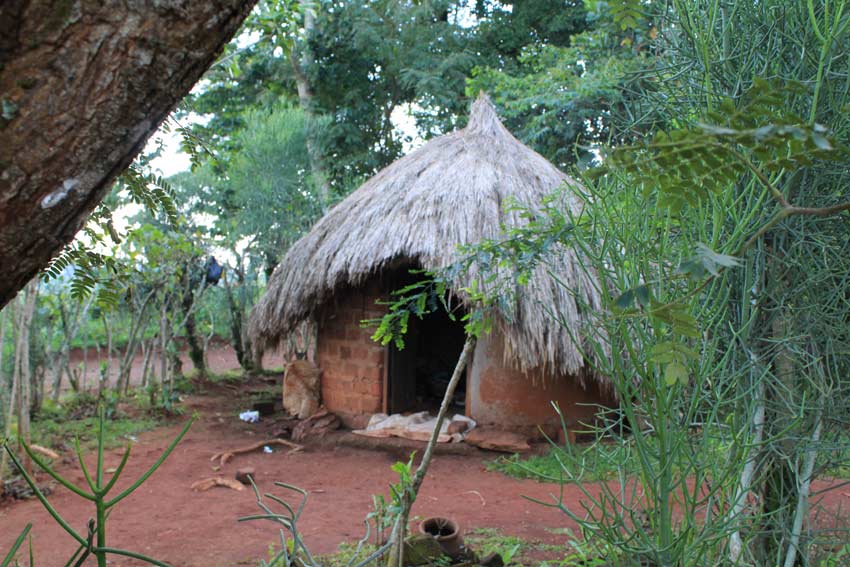
The medicine man's hut
The Bantu society
It seems that a long time ago many Bantu societies were organised along matrilineal lines and were governed by women; a whole heap of oral legends testifies to this, and female founding ancestors - where they exist in tradition - are as venerated and respected as their male counterparts.
Being a settled culture, the Bantu were inherently at risk of attack from the mobile nomadic Nilotic and Cushitic cattle and camel herders such as the Maasai, Borana (Oromo) and Somali, and as a result many Bantu societies became characterised by their defensive nature. Bantu groups lived on open land (ideal territory for the herders), having preferred, for both economic (agricultural) and defensive reasons, to occupy the less accessible highland regions. Settlements were built with the greatest attention to defence and were also well concealed: Europeans found they could be walking only metres from a settlement without knowing of its existence. Some tribes, like the Kikuyu, became experts at adapting and adopting to new realities, and rarely resorted to conflict. Others, like the Chuka, developed an array of inventive defensive measures, ranging from ingenious traps to tree houses and fortifications. Almost all the Bantu groups also adopted a rigid system of age-sets (an idea possibly borrowed from the Nilotic or Cushitic peoples they came across), in which all people of similar age were initiated into an age-set, which together progressed through clearly defined phases of social responsibilities, functions and status, from initiation, through warriorhood, marriage and elderhood to death. The system ensured the cohesion of society, as well as enabling the development of the warrior system, by which all the young men of a given society would, shortly after initiation to adulthood and their age-set, take up the role of defending the entire society.
Nowadays, the Bantu's reliance on agriculture and latterly trade has meant that they are by far the richest people, at least in monetary terms. The downside is that their settlements are inevitably densely populated, a problem which has grown acute over the last few decades.
Religion - Ancestral Worship and Spiritualism
In the philosophy of the Black Africans (also of the Bantu), the central theme is vitality, the energy, all thinking and acting is focused on. It deals with ethics, metaphysics and the magical spirits that exert influences on life and are decisive for illnesses and the human fate. The people strive to acquire and have much power. Man is in the centre of the creation, and he/she shall make use of the powers available, decide freely between the higher and lower things, between good and evil. Abuse, evil magic, is supposed to re-establish order by means of sacrifices of reconciliation and ornithological purification. Worldview knows many dark and mysterious phenomenons, the people have to interpret and overcome by means of rites. There is distinguished between white and black magic, between the activities of the medicine man and the dark intrigues of bad magicians and witches - those demons that wreak havoc in the dark. Above all these powers, there is god, ghost and creator simultaneously, the Wise Man (medicine man oder a king - the ancestors, the progenitors, or the first mother). Religion is embedded in the teaching system of existence. The master imparts his knowledge and his experiences in dealing with the supernatural powers to his pupil. The medicine man, very often, also acts as priest and for the well-being of the community. He may transfer power and decide through the oracle when the time is ready to act. He protects, he heals, he exorcises, and it is he who performs rituals.
- The Buganda people believed in superhuman spirits. Balubaale were men who carried over into death. Mizimu were the ghosts of dead people. They believed that the soul still exists. The supreme power was the Creator, Katonda.
- The Banyankore: The people believed that Ruhanga was their creator of all and everything on Earth. They also believed that the evil power in human beings is able to take advantage of black magic in order to – in accordance with Ruhanga – interfere with faith and bring about illness, health, drought, death or even bareness. The legend of Ruhanga found its expression in the Emandwa cult, this is the worship and homage of various gods who assumed their special meaning and importance in families and clans people in their honour, there had to be celebrated certain rituals.
- The Banyoro: Death was usually attributed to sorcerers, ghosts and other non-human agents. Death was the result of action on the side of bad neighbours, provided with a vast range of magical and semi-magical means of injuring and even killing others. Indeed, many deaths were attributed to the act of sorcery by ill-wishers. They celebrated the new moon and an annual ceremony called "Empango"
- The Basoga: Spiritual rites were performed by those authorized. Ancestral worship was also practised, and many gods and semi-gods as well as Lubaale, their creator, were worshipped. In general, they believed in animated nature which had to be offered sacrifices.
Songs and Dances of Bantu Women
The music of women in Bantu tribes is quite often part of the fabric of expression, which tells us who they are, not individually, but as a group - not in challenge to their culture, but in harmony with and support of the dominant and dynamic patterns of their culture. The songs and dances can be understood fully only by a tribe member, but we can benefit from an approach that looks at the textual content, the style (which includes their approach to composing), and the function of the songs and dances.
There is a conflict of presenting and, no doubt, mis-representing the dances and songs that have been extracted from the Bantu cultures. The weight of this wrong is proof to the vital interconnectedness of music and ways of life and meanings in Bantu culture. This has been said of many African cultures. Some Bantu-language have an expression for this loss of value in such an extraction: "You can take a feather from a bird, but when you get home that will not make you fly." In this way, music reflects a deep belief in the power of music to keep their life and culture alive. The traditional songs in women's lives, which they accompany, give proof for this. Thus, what we can see of the music and dance is out of context, but nonetheless all of its elements and expressions are purely reflective and confirming of life as it is in the culture of its origin. Also, we would have myopic view of women in Bantu cultures if we did not examine the African musical sensibilities that are the broader attitude towards music within culture. "Like a ritual or a musical event, an African community, too, is basically an ordered way of being involved through time. Africans rely on music to build a context for community action and, analogously, many aspects of their community life reflect their musical sensibility". Conventional to Western understanding of music is the identification of a work or song as a production of a single composer. However, composership in the African music system is not usually known to be authored by a particular individual. Either all the music is truly collaborative (not the case) and/or it is not important that individuals are credited with its creation. Music is often understood as a product of divine as well as mundane natural rhythms that are interpreted by villagers collectively. Again, music does not form a separate entity (from dance and from the holistic and daily culture); it is a communal production. Women, especially, have the solidarity of the other women and do not need to take individual credit for the composition they have created. Also, much of the song material is retained from generation to generation. The security of the form and the song allow for some freedom within it. The structure is so well known that individual women, especially dominant in voice, will improvise above that and thus transform aspects of the fabric of that song. The women who live this music do not seek originality but harmony. Especially in the group work songs it is clear that knowing the song and how it helps one to go about one's work in the village is more important that who first sung the melody. African women derive power and strength from social structure. It seems clear that we often consider women who defy social standards to be most powerful. An African woman expresses in her music that she is empowered by her positions as fixed by her culture. The song or dances, in their lyrics and in their place within a woman's world, provide an affirmation of identities such as mother, tiller of the earth, grinder of meal, midwife, socializing teacher or elder, or spiritual guide. The songs can be explicit messages to the community or a particular part of the community. They can be functional, providing necessary rhythms for human activity. Also, they can be narrative of an ongoing event or of well-known individuals. The women are the guardians of the life circle, from birth, through productivity and to death and again to birth. Musical elements that reflect the importance of a song within the unity of village women include: call and response, reassurance of participation (common inconverstion, too), apart-playing. "Africans respect ritualized social arrangements to externalize and objectify their sense of relationship because if a relationship is to be meaningful to them, the recognition one person gives another must be visible outside their own private involvement."
Ritual Songs when twins are born - If the woman gives birth to twins, she will go to dance with some people as one of the rituals of inviting the twins into the community.
In this celebration there is fabricated an abalongo ring (which means twins). In this ring, the umbilical cord will be embedded and shall protect the twins and their parent in the future against any harm. In a basket, there is collected for the twins (see picture at the front page of the booklet).
The mother of twins is the Nnaalongo. The father of twins is Ssaalongo. When twins are born, this will be seen as a special omen issued by the higher sky god. In this way, the community will praise the parents by means of a number of songs during their initiation rites, and these are some of them.
Songs of the Baganda
1. Kusi Ku Nalongo Kusi Ku Salongo - Praising the mother and father of twins
- ritual song of the Baganda people (Bantu).
- Israel Kalungi - lead voice, engalabi (long drum)
- Sylvia Namulema Kigula - backing voice
- Eric Lutaaya Jjemba - backing voice
- Ritah Kobusinge - embuutu (big drum), backing voice
In Buganda it is considered a sign given by god if father and mother give birth to twins. They are supposed to be great partners, who are praised in this song.
4. Lubaale wa Baana - Gods of the children
- ritual song of the Baganda people (Bantu)
- Sylvia Namulema Kigula - lead voice, backing voice
- Israel Kalungi - engalabi (long drum), backing voice
- Eric Lutaaya Jjemba; ensaasi (shakers), embuutu (big drum), engalabi (long drum), backing voice (voice of the lead god - possesed)
- Ritah Kobusinge - namunjoloba (small drum), backing voice
The protectors (gods) are called for help, to come to help the Baganda people solving their problems. The gods appear in a human form and help the community to solve their problems. They help the people and provide them with what they need.
6. Abalongo Twabazala Babiri ne Nalongo - Together with Nalongo, twins have been born
- ritual song of the Baganda people (Bantu)
- Eric Lutaaya Jjemba - lead voice, backing voice, ensaasi (shakers)
- Sylvia Namulema Kigula - backing voice
- Ritah Kobusinge - namunjoloba (small drum), backing voice
- Israel Kalungi - embuutu (big drum), engalabi (long drum), backing voice
In this song, father and mother are praised for having given twins to the community, because they are special human beings to bring two souls to life at once.
Songs of the Banyankore people
2. Muziguri Zitahe - Open the door for the gods to come home
- ritual song of the Banyankore people (Bantu)
- Ritah Kobusinge - lead voice
- Sylvia Namulema Kigula - backing voice
- Eric Lutaaya Jjemba - backing voice
- Israel Kalungi - embuutu (big drum)
This song invokes the gods to come to the people. The community has to open the doors for them to come in.
Songs of the Banyoro people
3. Omukago - Blood-pact friendship
- ritual song of the Banyoro people (Bantu)
- Ritah Kobusinge - lead voice, backing voice
- Sylvia Namulema Kigula - backing voice
- Israel Kalungi - embuutu (big drum)
- Eric Lutaaya Jjemba - namunjoloba (small drum), ebinyege (rattles), backing voice
This is a blood-pact between two friends that become brothers.
Songs of the Basoga people
5. Nabirye Yazaala - Nabirye gave birth to twins
- ritual song of the Basoga people (Bantu)
- Ritah Kobusinge - lead voice, backing voice
- Sylvia Namulema Kigula - backing voice
- Eric Lutaaya Jjemba - namunjoloba (small drums), backing voice
- Israel Kalungi - embuutu (big drum), engalabi (long drum)
This song will be sung by the community members to let everyone know that Nabirye from their own village has given birth to twins, and everyone must celebrate because it is a sign that the gods are happy.
- more information about Baganda, Banyankore, Banyoro and Basoga (Bantu people) see: The Bantu poeple
Instruments
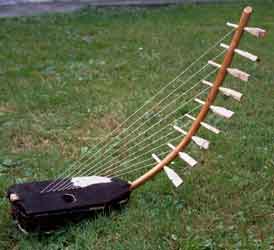 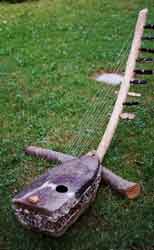
|
- Adungu – bow harp - arched harp - string instument
The adungu is a nine-string arched (bow) harp of the Alur people of northwestern Uganda. It is very similar to the tumi harp of the neighbouring Kebu people, and it is also used by the Lugbara and Ondrosi tribes in this northwestern region around the Nile. The harp is used to accompany epic and lyrical songs, and it is also used as a solo instrument or within ensembles. Players of arched harps have had a high social status and are included in royal retinues. Nowadays they also play in churches.
The adungu consists of an arched neck, a wooden resonator (sound box) in which the neck is fixed, and a series of parallel strings of unequal lengths that are plucked. The strings are fixed at one end to the resonator and run at an oblique angle to the neck, where they are attached and tuned with pegs.
|
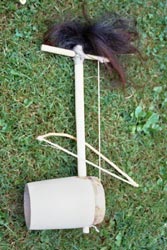
|
- Endingidi – tube fiddle - one-string-fiddle - string instrument
This instrument is popular in the Buganda, Busoga, Ankole, Kigezi, western Nile, and Acholi regions. It consists of a single string, which is attached to a flexible stick and will sometimes have a resonator. Unlike other single-string instruments, it is played with a bow.
|
Drums in African tradition bring the power that drives a performance. Music is not merely entertainment, but it is ultimately bound to visual and dramatic arts as well as the larger fabric of life. Drums may be used for "talking"; that is, sending information and signals by imitating speech. Many African languages are both tonal (that is, meaning can depend on pitch inflections) and rhythmic (that is, accents may be durational), giving speech a musical quality that may be imitated by drums and other instruments. Drumming music and dance are almost always an accompaniment for any manner of ceremony; birth, marriages, funerals.
Engoma (Uganda drumset - percussion instrument) - While larger versions of this drum are traditionally hand-carved from old-growth hardwood trees, now these drums are made with pinewood slats tied together like barrels. Smaller drums are laminated and turned on a lathe and may be provided with a rope carrying the handle. All these drums have heads made from hide held by hardwood pegs hammered into the side of the drum.
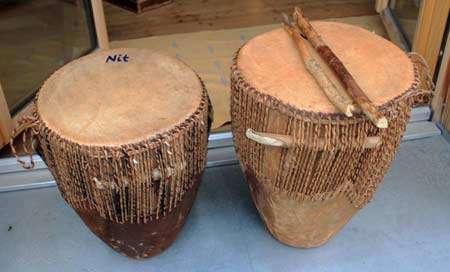
|
- Namunjoloba
- small drum - percussion instrument
|
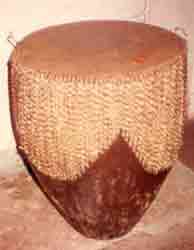 |
- Embuutu
- big drum - percussion instrument
|
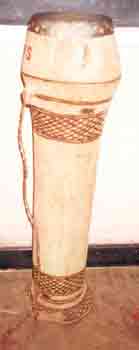 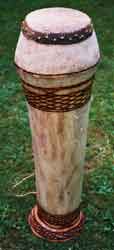
|
- Engalabi - long drum - percussion instrument
This traditional drum has a head made of reptile skin nailed to a wooden sound body.
The engalabi from the Buganda region has an important roles in ceremonies and in theater. It is called "okwabya olumbe". This is the installation of a successor to the deceased, thus the saying in Luganda (in Buganda a Bantu dialect) "tugenda mungalabi", meaning we are going to the engalabi, that is, long drumming.
Rule in playing the drum is the use of bare hands.
|
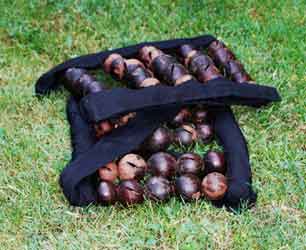
|
- Ebinyege
- rattles - percussion instrument
These originate in Bunyoro and Batooro (Toro) in Western Uganda along the roots of mountain Rwenzori. The seeds are put in these dry fruits to produce rhythmic patterns when shaken. Ebinyege are tied on the males legs to produce the sound and the Runyege dance (courtship dance of the Batooro) is named after the ebinyege, hence an important prop.
|
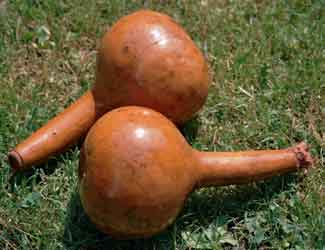
|
- Ensaasi - shakers - percussion instrument
Shakers are made in pairs from gourds or shells, sometimes with stick handles, and are used to accompany other traditional instruments in Uganda. The central and northern (Alpaa) regions have shakers that produce a continuous sound as beads move from side to side in the gourd or shell. Generally, these shakers produce sounds by many small objects, such as pebbles, rattling together inside the body.
|
Revised by Hermelinde Steiner 2013
PageTop

|
